By: Benoit Azagoh-Kouadio
The springtime turn brings out one of our favorite vernal vegetables at Round the Bend Farm (RTB): Nettles!
Infamous itches, riling rashes, and bristly burns, who does not know the common “Stinging Nettle”  from the many motherly admonitions and filial fears it inspires? Here at RTB, we value the lowly nettle for the princely powerhouse of nutrition and medicinal majesty it hides beneath its fearsome bite. Emerging from perennial roots, both cultivated and wild, nettle is one of the first spring herbs to pop from the field, forest and garden. High in iron, protein, potassium, silica, vitamins A, K and C, these spritely spring greens make good eating for just about everything alive — soil, plants, animals …and especially humans! Medicinally, nettles have profound effects on the human body. They work towards reducing inflammation, potentiating the immune system, improving kidney and adrenal function, and aiding the body’s ability to detox. At RTB, we like to see the kitchen as the meeting place of gastronomy and pharmacy, and in that respect nettles are one of our favorite guests.
from the many motherly admonitions and filial fears it inspires? Here at RTB, we value the lowly nettle for the princely powerhouse of nutrition and medicinal majesty it hides beneath its fearsome bite. Emerging from perennial roots, both cultivated and wild, nettle is one of the first spring herbs to pop from the field, forest and garden. High in iron, protein, potassium, silica, vitamins A, K and C, these spritely spring greens make good eating for just about everything alive — soil, plants, animals …and especially humans! Medicinally, nettles have profound effects on the human body. They work towards reducing inflammation, potentiating the immune system, improving kidney and adrenal function, and aiding the body’s ability to detox. At RTB, we like to see the kitchen as the meeting place of gastronomy and pharmacy, and in that respect nettles are one of our favorite guests.
How does one cook these little green medicine boxes in hiding? Traditionally, nettles are often prepared in the same way as spinach — washing, cooking or drying all being sufficient ways to remove the “sting” and by so render them MUCH more palatable. These two simple recipes below (which we use at the farm) add a new, adaptable and easy-to-do take on this most misunderstood herb.
Nettle Pesto
5 thick, hand-held bunches (approx.) Stinging Nettles, washed and separated from any thick or woody stalks (*) (**)
2-4 Tbs pine nuts, sunflower seeds, almonds or walnuts
1/2 cup olive oil
2 large garlic cloves
Salt, pepper or spices to taste
Instructions:
- Place all ingredients in food processor.
- Blend until desired paste-like consistency achieved.
- Store short term in fridge, or freeze in plastic containers for consumption throughout the year.
- Use it on everything!
* Younger plants and new growth are more tender and tasty.
** Feel free to use your inspired creativity to add other early herbs to this mix. At RTB, we have an abundance of the equally virtuous chickweed, and other cool weather leafy greens such as arugula and radish tops could add a piquant blast of pungent flavor to this healthy spread. In the late summer when nettles return, we like to add the last bits of our basil plantings for a more traditional taste.
Nettle Infused Cider Vinegar
A quantity of Stinging Nettle… as much as you can fit*
Organic Unpasteurized Apple Cider Vinegar
Instructions:
- Fill a glass vessel — at the farm we use 1 qt and 1/2 gallon wide mouth Ball canning jars — as full as you can with fresh stinging nettles [cutting or tearing them may be helpful but no need to worry about removing the stems]
- Pour the apple cider vinegar into the jar until it reaches the top and the nettles are completely covered.
- Fasten the lid and leave the jar on a shelf or sill to infuse for at least 1 month.
- Decant the infused vinegar and use a gourmet touch on all your cooked dishes or as mineral-rich, fortifyingly scrumptious base for salad vinaigrettes.
* Again, feel free to experiment and add other early herbs into the mix. Is that garden tuft of chickweed calling you? Young dandelion greens in the meadow? Onion grass? The first sprigs of oregano and thyme? Why not!



